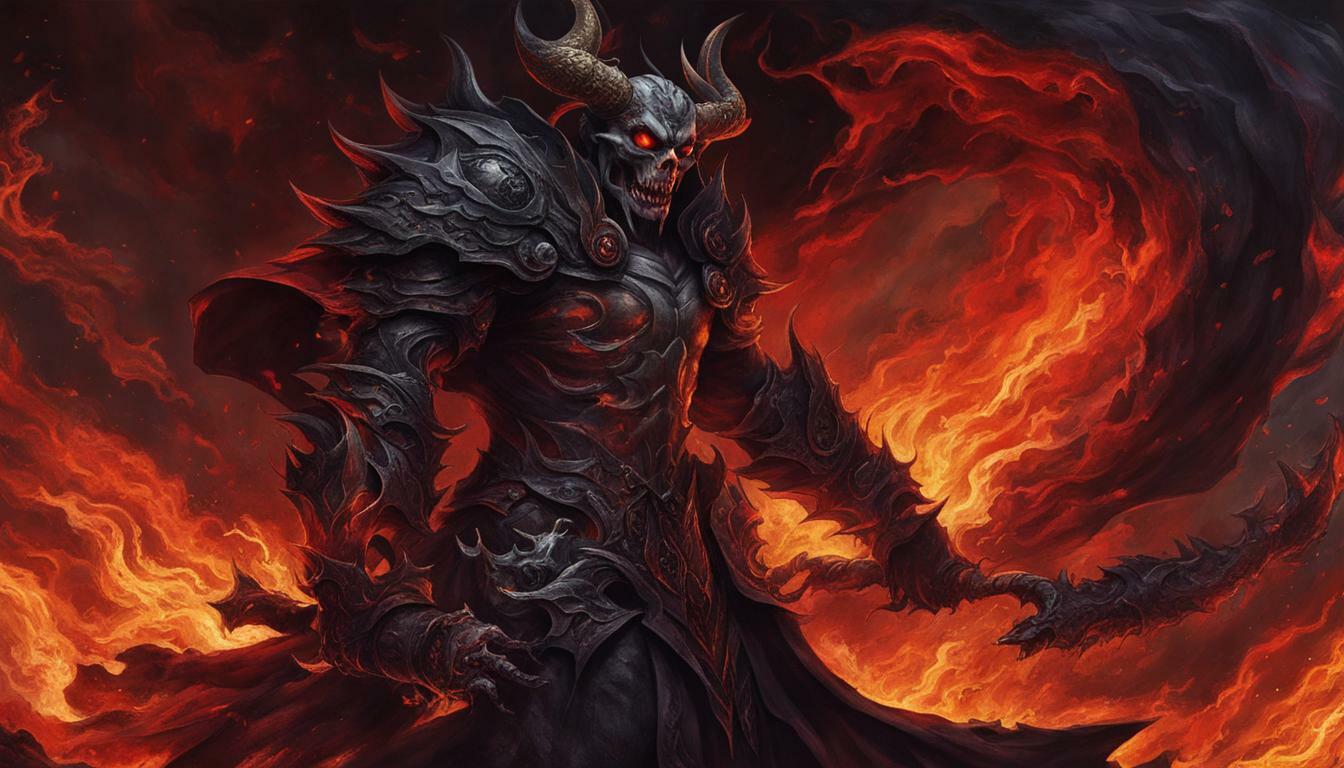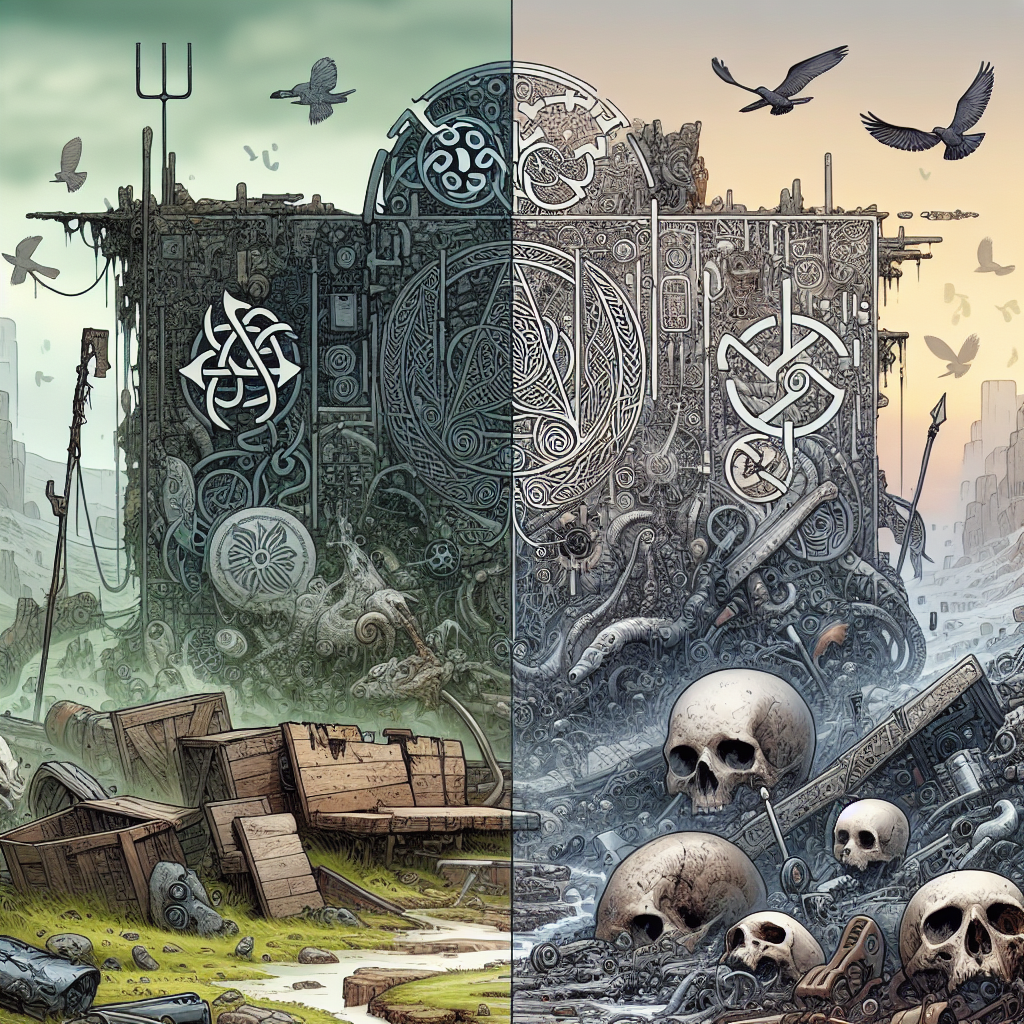Welcome to our exploration of the difference between Hell and Hades. Despite being known as the realms of the afterlife, these two concepts have unique interpretations and meanings attributed to them. In this article, we will delve into the intricate differences between Hell and Hades and explore their distinct characteristics within their religious and mythological contexts. Let’s take a closer look at the comparison between Hell and Hades and gain a better understanding of these underworld realms.
Key Takeaways
- There is a difference between Hell and Hades, despite their being known as realms of the afterlife.
- Religious and mythological traditions have their own unique interpretations and meanings of Hell and Hades.
- Understanding the differences between Hell and Hades is important within their respective cultural and religious contexts.
Understanding Hell and Hades
Before we delve into the differences between Hell and Hades, it is important to understand what these concepts mean and how they came to be. Hell is typically viewed as a place of punishment and suffering in the afterlife, often associated with the Christian religion. Meanwhile, Hades, from ancient Greek mythology, generally refers to the underworld, the realm of the dead.
While these two concepts may seem similar, they have distinct origins and meanings that have evolved over time.
The Origins of Hell
The concept of Hell as a place of eternal punishment can be traced back to early Christianity, with references to the “lake of fire” in the book of Revelation. This idea of eternal damnation became a fundamental part of Christian theology, with various interpretations and depictions emerging over the centuries.
Some Christians view Hell as a physical place, while others see it as a state of being. The punishments associated with Hell also vary depending on the interpretation. According to some, Hell is a place of flames and torment, while others view it as a place of separation from God.
The Origins of Hades
In ancient Greek mythology, Hades was both the name of the god who ruled the underworld and the realm itself. The Greeks believed that after death, souls would travel to the underworld and be judged by Hades or his assistants. Depending on their lives, souls would be sent to either the Elysian Fields or Tartarus.
The underworld was seen as a gloomy and depressing place, where the dead existed in a shadowy existence. However, it was not necessarily a place of punishment, but rather a place where the souls of the dead resided.
How Hell and Hades are Portrayed in Various Religious and Mythological Traditions
The concepts of Hell and Hades have been portrayed in various ways throughout history, appearing in religious and mythological traditions across the world.
In Christianity, Hell is often depicted as a fiery place of punishment, where sinners are doomed to eternal suffering. In contrast, Hades is portrayed in Greek mythology as a dark and dismal place where the dead reside, but not necessarily a place of punishment.
Other cultures have their interpretations of the afterlife, with varying depictions of Hell or Hades-like realms. For example, in Egyptian mythology, the dead traveled through the underworld and underwent a judgment process before proceeding to their afterlife.
By understanding the origins and meanings of Hell and Hades, we can better appreciate their significance and cultural context. In the following sections, we will explore the religious and mythological perspectives of these concepts, as well as the differences in beliefs about them.
Hell and Hades in Religion
Hell and Hades are often associated with religious beliefs, holding significant importance in various faiths around the world. The interpretation of these underworld realms varies depending on the particular religion and culture.
In Christianity, Hell is often depicted as a place of eternal punishment for sinful behavior. It is commonly believed that after death, the soul is judged and sent to either Heaven or Hell based on their actions during their lifetime. Hell is portrayed as a fiery abyss, where the suffering is unbearable and never-ending. On the other hand, Hades is often associated with ancient Greek mythology, where it is the underworld inhabited by the dead. It is not necessarily a place of punishment, but rather a destination for all souls after death. Hades is where the souls of the deceased go to live out the remaining of their afterlives.
The interpretation of Hell and Hades in other religions is often different. In Hinduism, for example, it is believed that the soul reincarnates after death, and no single place of torment or punishment exists. In Buddhism, one can be reborn in different realms based on their karma, and there is no specific concept of Hell or Hades.
Interpretations of Hell and Hades also vary within Christianity itself. Some denominations believe in the concept of a literal Hell, while others interpret it as a metaphorical state of separation from God. Similarly, in Greek mythology, there are variations in the depiction of Hades and its role in the afterlife.
The varying interpretations of these underworld realms within different religions and cultural contexts highlight the importance of understanding the unique beliefs and interpretations of each.
Hell and Hades in Mythology
In mythology, both Hell and Hades are believed to be underworld realms that are ruled by powerful deities. In ancient Greek mythology, Hades was the god of the underworld and was responsible for the souls of the dead. He was depicted as a stern and emotionless figure who ruled over the deceased with an iron hand. Hades was also known as the god of wealth, as he controlled the precious metals that were found underground.
In Christianity, Hell is often portrayed as a place of eternal suffering, reserved for those who have committed grave sins during their lifetime. The idea of Hell as a fiery pit of torment is deeply ingrained in the religious beliefs of many Christians. However, the concept of Hell as a physical place is not present in all Christian denominations, with some interpreting it as a symbol for the spiritual suffering that comes from being separated from God.
Many other cultures and religions have their own interpretations of Hell and Hades. In Norse mythology, for example, the goddess Hel rules over the realm of the dead, which is also called Hel. The Japanese shinto religion has a similar concept, with Yomi being the underworld realm where the dead reside.
Hell and Hades in Christianity
In Christianity, Hell is often described as a place of eternal punishment, where the souls of sinners are sent to suffer for all eternity. This belief is based on the idea that God is a just and righteous deity who must punish those who have committed serious sins. In many Christian denominations, Hell is seen as a physical place of fire and brimstone, where lost souls are tormented by demons and other malevolent beings.
On the other hand, Hades in Christianity is often used as a synonym for Hell. However, there are some differences in interpretation between the two. In some religious traditions, Hades is viewed as a more neutral realm where the dead reside. It is not necessarily a place of punishment, but rather a place where the souls of the dead go after they have passed away.
In conclusion, while Hell and Hades share some similarities as underworld realms, they have unique interpretations and meanings in different cultures and religions. Understanding these differences is crucial for gaining a deeper appreciation of the beliefs and traditions that have shaped our world.
Difference in Beliefs about Hell and Hades
The concept of Hell and Hades varies significantly depending on one’s religious and cultural beliefs. Some faiths view these places as physical locations, while others see them as spiritual realms. The beliefs surrounding the functions, punishments, and inhabitants of these underworlds are equally diverse.
For instance, in Christianity, Hell is often depicted as a place of eternal punishment for sinners, where they endure various forms of torment. Alternatively, in ancient Greek mythology, Hades, the god of the underworld, ruled over the dead and was responsible for delivering punishment to the wicked. Unlike Christianity, Hades was not a place of torment, but rather a neutral place where the dead resided.
Similarly, different cultures have their own interpretations of who and what resides in Hell and Hades. In Hinduism, the underworld is known as Naraka, and the belief is that souls reside there temporarily to pay for their sins before being reincarnated. On the other hand, some African cultures believe that the underworld is inhabited by ancestral spirits who can impact the living world.
The differences in beliefs about Hell and Hades are not limited to their functions and inhabitants, but also extend to their symbolism. Hell is often associated with fire, darkness, and demons, while Hades is associated with death, the afterlife, and the underworld.
It is important to consider the unique interpretations and meanings of Hell and Hades within their respective cultural and religious contexts. Understanding these differences can help broaden our knowledge and appreciation for the diverse beliefs and traditions of various societies around the world.
The Unique Interpretations and Meanings of Hell and Hades
Throughout history, Hell and Hades have both been used to represent the afterlife realm of punishment and suffering in different ways. However, the unique interpretations and meanings of these concepts have evolved over time, depending on the religious and cultural perspective in which they are viewed.
For instance, in Christianity, Hell is often depicted as a fiery underworld where souls are punished for their sins, whereas Hades, in ancient Greek mythology, is more like a shadowy realm where the dead exist in a state of darkness and gloom. The idea of Hell as a place of eternal punishment is not found in Greek mythology. Instead, Hades is ruled by the god of the underworld, also named Hades, who acts as a caretaker for the dead.
In Hinduism, the concept of Hell is not as prominent as it is in Abrahamic religions. Instead, they have a similar concept called Naraka, which is a place of temporary punishment for the souls before they are released back into the world. Similarly, in Buddhism, the idea of Hell is not a permanent destination; rather, it is viewed as a state of mind that can be transcended through meditation and self-reflection.
These differences in beliefs about Hell and Hades reflect the unique cultural and religious contexts in which they have been developed. While they both represent the afterlife realm of punishment, the specific interpretations and meanings of Hell and Hades vary greatly depending on the belief system in which they are situated.
Furthermore, the symbolism associated with Hell and Hades is also significant. In Christianity, Hell is often associated with the devil and demons, while in Greek mythology, Hades is associated with the god of the underworld and the three-headed dog, Cerberus. These symbols help to convey the specific interpretations and meanings of Hell and Hades, adding to their overall significance.
Overall, the difference in beliefs about Hell and Hades reflects the diverse cultural and religious contexts in which they are situated. Understanding the unique interpretations and meanings of these concepts is essential in appreciating their significance in different mythological and religious traditions.
Conclusion
In conclusion, understanding the difference between Hell and Hades requires a comprehensive analysis of their unique interpretations and meanings. As we have discussed, these underworld realms have different origins, and their representation varies across different cultural and religious traditions.
While Hell is widely associated with Christianity and the concept of eternal damnation, Hades is part of ancient Greek mythology and represents a transitional stage between life and death. The differing beliefs about the functions, punishments, and inhabitants of these realms reflect the unique perspectives of their respective cultures.
As our understanding of these concepts has evolved over time, the symbolism associated with Hell and Hades has become more nuanced and complex. While Hell is often seen as a place of punishment, it can also symbolize a state of separation from the divine. Similarly, Hades can represent the journey of the soul towards enlightenment and transcendence.
Overall, recognizing the differences between Hell and Hades is crucial for gaining a deeper understanding of the cultural and religious beliefs that have shaped our understanding of the afterlife. By exploring their varied interpretations and meanings, we can gain a greater appreciation for the diversity of human experience and the rich symbolism that has been woven into our cultures and traditions.
FAQ
Q: What is the difference between Hell and Hades?
A: Hell and Hades are both underworld realms, but they are found in different religious and mythological traditions. Hell is often associated with Christianity and is depicted as a place of eternal punishment for the wicked. Hades, on the other hand, comes from Greek mythology and is seen as the realm of the dead, where souls go after death.
Q: How are Hell and Hades portrayed in various religions?
A: In Christianity, Hell is often described as a fiery place of torment, inhabited by demons and where sinful souls suffer for eternity. In Greek mythology, Hades is seen as a shadowy realm ruled by the god of the same name. It is a place where all souls, regardless of their deeds in life, reside after death.
Q: Are there any cultural differences in the interpretations of Hell and Hades?
A: Yes, there are cultural differences in how Hell and Hades are interpreted. Different religions and mythologies have their own unique beliefs about the afterlife and the nature of these underworld realms. For example, in some cultures, Hell may be viewed as a temporary place of purification before souls can enter heaven.
Q: What are the punishments in Hell and Hades?
A: In Christianity, Hell is often associated with intense suffering and eternal damnation for those who have committed grave sins. In Greek mythology, Hades is more of a neutral realm, where souls of the deceased go to live a quiet existence without any specific punishments or rewards.
Q: Are there specific beings associated with Hell and Hades?
A: Yes, in Christian beliefs, Hell is inhabited by demons and fallen angels who torment the souls of the damned. In Greek mythology, Hades is ruled by the god of the same name and is inhabited by various mythological beings, such as the three-headed dog Cerberus, who guards the entrance to the underworld.
Q: How have the interpretations and meanings of Hell and Hades evolved over time?
A: The interpretations and meanings of Hell and Hades have evolved significantly throughout history. Different cultures and religious traditions have influenced and shaped the understanding of these realms. For example, the concept of Hell in Christianity has undergone various interpretations and changes over centuries.
 Skip to main content
Skip to main content


